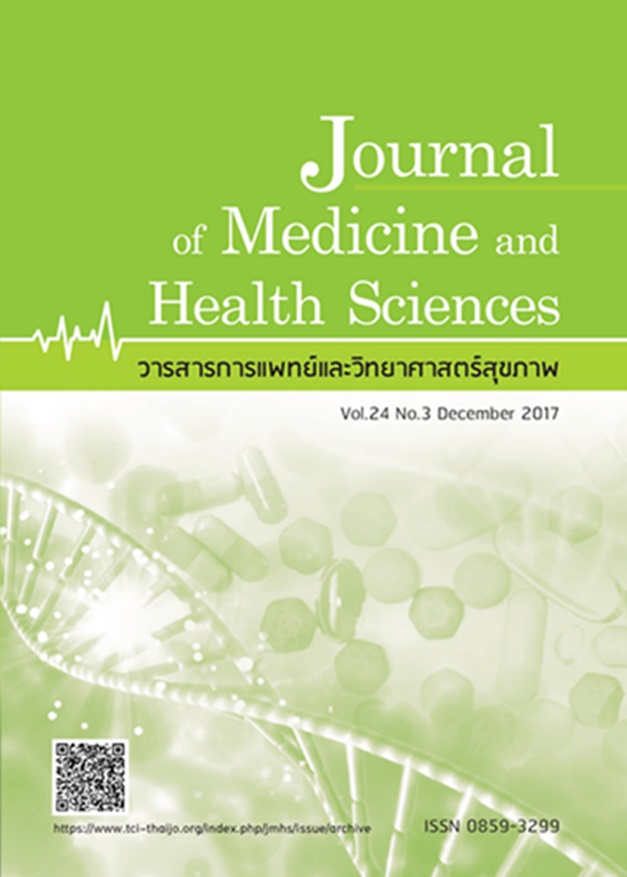บทบาทของข้าวไทย 6 ชนิด สำหรับการแยกเชื้อราทางการแพทย์กลุ่ม Microsporum canis
คำสำคัญ:
Microsporum canis, ข้าว, Rice grain test, /Microsporum canis, Rice, Rice grain testบทคัดย่อ
Microsporum canis จัดเป็นเชื้อราที่ก่อโรคกลากที่พบบ่อยในสัตว์ รวมถึงสามารถก่อโรคได้ในคนได้เช่นกัน โดยเฉพาะอย่างยิ่งในเด็ก การตรวจการติด M. canis นั้นสามารถตรวจได้เบื้องต้นในห้องผู้ตรวจผู้ป่วยนอก โดยการใช้ Wood’s lamp ultra-violet light ซึ่งพบว่า M. canis สามารถให้การเรืองแสงสีเขียวปนเหลืองได้คล้ายๆ กับ M. audouinii สำหรับการตรวจวินิจฉัยทางห้องปฏิบัติการนิยมใช้ Rice grain test เพื่อพิสูจน์ชนิดของเชื้อ แต่ยังไม่มีการระบุว่าข้าวสายพันธุ์ไหนที่เหมาะสมที่สุด ดังนั้นคณะผู้วิจัยจึงทำการเปรียบเทียบอัตราการเจริญเติบโตของ M. canis ในข้าวสารและข้าวหุงสุกทั้งหมด 6 ชนิด ได้แก่ ข้าวหอมมะลิ ข้าวเสาไห้ ข้าวไรซ์เบอร์รี่ ข้าวกล้อง ข้าวเหนียวขาว และข้าวเหนียวดำ คัดเลือกชนิดของข้าวที่เหมาะสำหรับการเพาะเลี้ยงและพิสูจน์เบื้องต้นของ M. canis ในห้องปฏิบัติการ งานวิจัยนี้ใช้ M. canis จำนวน 3 สายพันธุ์ ได้แก่ M. canis TMMI001MC, M. canis TMMI002MC และ M. canis TMMI003MC พบว่าเชื้อทั้ง 3 สายพันธุ์เจริญเติบโตได้ดีเฉพาะในข้าวหุงสุกเท่านั้น และเมื่อเปรียบเทียบการเจริญเติบโตในข้าวหุงสุกทุกสายพันธุ์พบว่า ข้าวเหนียวขาวทำให้ M. canis เจริญเติบโตได้เร็วที่สุดเมื่อเทียบกับกลุ่มควบคุม นอกจากนี้จำนวนของการสร้างโคนิเดียขนาดใหญ่ (macroconidia) ของ M. canis ขึ้นกับสายพันธุ์ของเชื้อ โดยพบว่าข้าวที่มีสี ทำให้เชื้อเจริญได้ดีกว่าข้าวที่ไม่มีสีใน M. canis 2 สายพันธุ์ ได้แก่ M. canis TMMI001MC สร้างโคนิเดียขนาดใหญ่เฉลี่ยมากที่สุดบนข้าวกล้องและ M. canis TMMI002MC ซึ่งสร้างโคนิเดียขนาดใหญ่เฉลี่ยมากที่สุดบนข้าวไรซ์เบอร์รี่ นอกจากนี้ M. canis TMMI003MC สามารถเจริญและสร้างโคนิเดียขนาดใหญ่ได้ดีในข้าวที่ไม่มีสี โดยความแตกต่างของข้าวสายพันธุ์กลุ่มที่มีสีคือ มีธาตุอาหารรอง (trace element) และสารต้านอนุมูลอิสระ (antioxidant) ซึ่งอาจเป็นปัจจัยหนึ่งที่เกี่ยวข้องกับการเจริญเติบโตของเชื้อ จึงสรุปได้ว่า ข้าวหุงสุกสายพันธุ์ที่มีสี มีแนวโน้มที่ดีในการเลือกนำมาใช้ในการพิสูจน์ชนิดของ M. canis ด้วยวิธี Rice grain test
Microsporum canis is a pathogenic fungus causing Tinea diseases which can be detected in animals and humans especially in infants. General diagnosis can be performed in out-patient department by using Wood’s lamp ultra-violet light. The greenish-yellowish illuminated lesion after being exposed the UV light can be detected in M. canis infected lesion similar to M. audouinii infected lesion. However, rice grain test is a common method that being used to confirm the M. canis infection in the laboratory. To determine whether which types of rice grain (Oryza sativa L.) represent the most effective candidate for testing M. canis infection, we determined the growth of M. canis on six types of Thai polished rice grain including Thai jasmine rice, Saohai rice, Riceberry rice, brown rice, white glutinous rice, and black glutinous rice. Both uncooked and cooked rice grains from six types of Thai rice were used to grow 3 strains of M. canis including M. canis TMMI001MC, M. canis TMMI002MC, and M. canis TMMI003MC. We found that all 3 strains of M. canis grew only on the cooked rice. Moreover, we found that M. canis cultivated fastest when cultured with cooked white glutinous rice compared to control. The amount macroconidia formation are varied in each strain of M. canis. In addition, the M. canis grew better in colored rice grains when compared to non-colored rice grains. The highest averaged amount of macroconidia formation from M. canis TMMI001MC was observed in brown rice culture. On the other hand, M. canis TMMI002MC cultured with Riceberry rice exhibited the highest averaged amount of macroconidia formation. Moreover, M. canis TMMI003MC could grow and produced maroconidia on non-colored rice grains. The results suggested that the trace elements and anti-oxidative compounds in colored rice grains may take part in promotion the growth of M. canis. In conclusion, the cooked-colored rice grains from Thai rice exhibit high potential candidate for evaluating the M. canis infection as a culture medium used in Rice grain test.
เอกสารอ้างอิง
clinical samples of children suffering from Tinea capitis in ismailia, Egypt.
Aust J Basic Appl Sci 2012;6(3):38-42.
2. Doddamani PV, Harshan KH, Kanta RC., et al. Isolation, identification and
prevelance of dermatophytes in tertairy care hospital in Gulbarga district.
People’s J Sci Res 2012;6(2):10-3.
3. Ekwealor CC and Oyeka CA. Cutaneous mycoses among rice farmers in Anambra
state, Nigeria. J Mycol 2013;2013:5.
4. Robert R, Pihet M. Conventional methods for the diagnosis of dermatophytosis.
Mycopathologia 2008;295-306.
5. Pandey A, Pandey M. Isolation and characterization of dermatophytes with
tinea infections at Gwalior (m.p.), india. Int J Pharm Sci Invent 2013;2(2):5-8.
6. Abou El-Khair EK, Taleb MH, Albasyony I.,et al. Tinea Capitis in North Gaza StripPalestine.
Asian J Dermatol 2014;6:1-15.
7. Moriello KA, Verbrugge MJ, Kesting RA. Effects of temperature variations and
light exposure on the time to growth of dermatophytes using six different
fungal culture media inoculated with laboratory strains and samples obtained
from infected cats. J Feline Med Surg 2010;12(12):988-90.
8. Suasa-ard W, Sommartya P, Buchatian P, et al. Materials suitable for mass
production conidia of white mascardine, Beauveria bassiana (Balsmo) Vuillemin.
National biological control research center Kasetsart Universtiy.
9. Abraham T, Easwaramoorthy S, Santhalakshmi G. Mass production
of Beauveria bassiana isolated from sugarcane root borer, Emmalocera
depresella Swinhoe. Sugar Tech 2003;5(4):225-9.
10. S o r n p r a s e r t R , S a e n k a m o n P , Chanbamrung C, et al. Cultivation
of Cordyceps militaris (L.) Link BCC 18247 Mycelium with Different Grains.
Chandrakasem Rajabhat University Journal 2012;18(35):83-91
11. Beigh SA, Soodan JS, Singh R, et al. Evaluation of trace elements, oxidant/
antioxidant status, vitamin C and betacarotene in dogs with dermatophytosis.
Mycoses 2014;57(6):358-65



